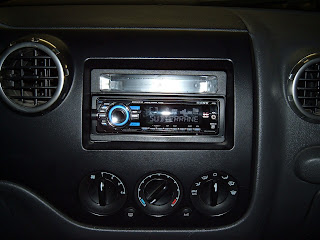I got home from work this morning about 8:30 after having been up a good part of the night. I went out and put the battery charger on the battery so when I got to the point of trying to start it, there would be plenty of juice. After sitting there for a month, it only had a 70% charge. I charged it up to 97% before I tried starting it.
Once I actually started working on the car, I moved the stuff off of the old radiator on to the new one and installed the new stuff I bought for it. It installed in about five minutes. I put on the belts, added oil to the crankcase, installed the fan shroud and fan. I put on the radiator hoses and then hooked up the intake air boot, the breathers that hook up to the boot, the MAF and the Air Filter Box. I connected the last two small coolant hoses that hook up to the thermostat switch on the Air Filter Box. Once that was complete, I filled the cooling system with plain water, just in case I have a problem, I didn't want to have to drain the new coolant back out.
Once I got to this point, I checked the battery and it was still at 90%, so I decided to go take a shower and get cleaned up. When my shower was finished, I checked the charge on the battery and it was at 97%, time to start the car.
My wife and daughter wanted to be out there when I started it, so they came out to the garage. I crossed my fingers and turned it over, it kept turning over and over, but wouldn't start. How depressing. I tried again, nothing. So I told the family that it wasn't going to start, and I started thinking about what could be wrong. I knew I'd done everything in a workman like manner. I went and got my code reader and it came up with one Fault Code "1A" which was the "Control Unit Supply ". I remember from when I worked on the 93 525i, I got the same code, which I found out most times means that the computer isn't sure what's going on since there hasn't been an electrical charge to it for some time. The one on the 93 cleared once I got it running. So, it must be something else.
As it was turning over, there was not even a hint that it wanted to start. When, I put the 93 back together after doing the Ping Sensors and Intake manifold gaskets, I switched the two gas lines going to the intake manifold. No fuel was getting to where it needed to go. Once I figured that out and corrected it, it started immediately. It is about a 15 minute job to move stuff out of the way enough to get to the fuel lines. As soon as I removed them, I knew it was the problem, there was a loud "POP" when I pulled off the back line from air in it. I don't know what happened, I thought that I had been very careful when taking it apart and marking where everything went. I guess I wasn't as careful as I should have been. It took me about another 15 minutes or so to put everything back together.
The second attempt at starting it went way better. It fired up after cranking it for about 5 seconds. It ran at idle a bit rough, but it was running. I gave it a bit of throttle and it smoothed right out. When I let off it ran rough. It was smoking a bit, probably due to the cleaner I used to clean the top of the pistons off and I coated the cylinder walls with a very thin coat of oil prior to re-assembly so it would not start up dry.
It never stalled on me in about 3 minutes of idling. I took it out for a drive to see how it reacted. It ran very smooth and had good power. I didn't push it, nice smooth starts and acceleration. The first mile it smoked a little when I would stop, but it quickly stopped doing that. The temp gauge stayed in the normal range while I drove it around.
I brought it home and parked it while idling. It is leaking a drip of oil every few seconds from the oil pan while it's running. I figure that may be due to the fact that I tried to take off the pan while doing this job. It does not appear to be leaking any oil from the head gasket or other seals I installed during the job. I did not find any water leaks yet.
So, it looks at this point in time that the Head Gasket Replacement was a success.
Here are some pictures of it all put back together. One from the left side and one from the right:





















